Power socket for an electric stove: types, design, technical standards and connection rules
Have you bought an electric stove - the dream of every zealous housewife? This really useful purchase will help you prepare a lot of delicious dishes without the use of open fire. True, its illiterate connection threatens to burn out the wiring, electrical shocks and short circuits. Agree, there is a risk.
In order to eliminate the listed extremely negative situations, you need a power outlet for the electric stove. Installation of the device guarantees trouble-free and safe operation if the installation rules are followed.
We will tell you in detail how to correctly select and install the specified type of electrical fittings. The information we offer is accompanied by step-by-step visual instructions and video tutorials.
The content of the article:
Types of power points for electric stoves
The installation of a new stove, especially an electric one, is necessarily accompanied by a connection procedure. Sometimes an electrician is invited to do this type of work, but more often they do it on their own.
To ensure that new equipment lasts a long time and that problems do not arise during operation, you should carefully consider the technical standards for its installation.
Particular attention should be paid to the selection and installation of the appropriate power connector. The opinion that for an electric stove it is enough to install the most ordinary socket is wrong.
It will not be able to withstand high loads and, at best, will simply melt. For powerful electrical appliances, special sockets are used that can withstand 7 kW or more.
Power sockets on the market differ in color, material, shape, installation method and load capacity. When purchasing this device, you must immediately buy the corresponding plug. Often, manufacturers of electric stoves equip their equipment with a power plug and socket - all that remains is to install them correctly.
Based on the material used, power sockets are made of carbolite and high-quality plastic. The first option is black, they are usually cheaper. Plastic ones are mainly available in white. They are more expensive, are of high quality and have a higher level of wear resistance.
According to the installation method, power sockets are distinguished:
- for open installation;
- hidden installation.
If it is to be installed behind a stove that sits tightly against the wall, then it is better to choose hidden installation models, the working mechanism of which is hidden in the wall.

Among high-power sockets you can find both options with a grounding contact and without grounding. For an electric stove you should buy socket with grounding.
The power supply in the house can be single-phase, three-phase and rarely two-phase. Based on this feature, you need to select a socket that has the necessary contacts and lay the appropriate power cable.
In order to choose the right power connector suitable for the electrical network entering the house, you need to find out in advance from the electricians servicing the site, the type of network and the presence of grounding. Their answers should be unambiguous and clear. Only after this can you begin to purchase and further install a power outlet yourself.
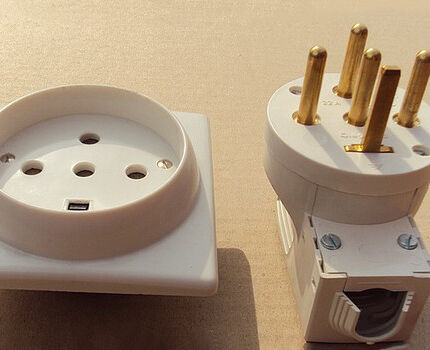
Features of the electrical device
A power connector (socket) that can withstand heavy loads is used for powerful household appliances. Its ability to pass through large values of rated current, compared with conventional household models, is the most important technical characteristic of the product.
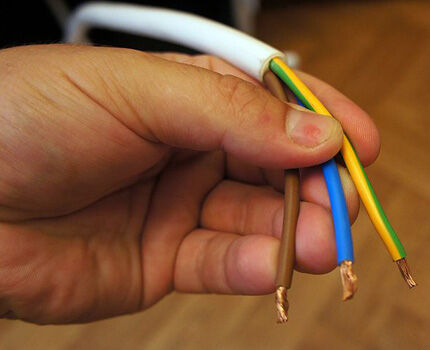
If simple sockets are designed for 10 A, 16 A, then power sockets are designed for 25 A, 32 A or more. Their contacts do not heat up when such current passes.
A high-power electrical outlet, like a regular socket, consists of a working mechanism, an external decorative lining that performs a protective function, and screws. The only difference is the design of the operating mechanism of the power outlet.
If you disassemble it, then inside you can see the input terminals for connecting the power cable and the output contacts that transmit electric current to the inserted plug.
Rules for installing a socket for an electric stove
The question of connecting a kitchen stove arises at the end of the renovation. At this time, the finishing work in the room has already been completed and the power cable has been laid. All that remains is connect the socket and the stove itself.
This is ideal. But it happens when such a question arises at the very beginning of repair work. Here you need to act consistently, following the basic rules.
#1: Preparing to Install a Power Outlet
The first step is to determine the installation location of the electric stove. It’s good to immediately choose a model to know its dimensions and, most importantly, power consumption. It is this characteristic that will determine which wire will be laid as the supply wire.
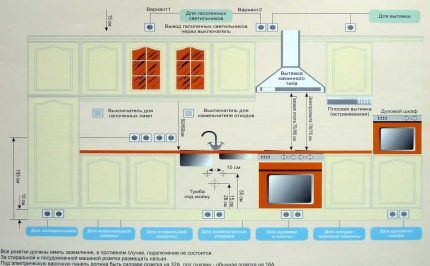
Having decided on the model of the device and its installation location, you will need to lay a separate power cable line from the panel to the kitchen. To do this, you need to select a wire with a cross section of 6 mm2. Definitely copper. It is better to take high-quality wiring that complies with GOST, because the safety and long-term operation depend on its quality.
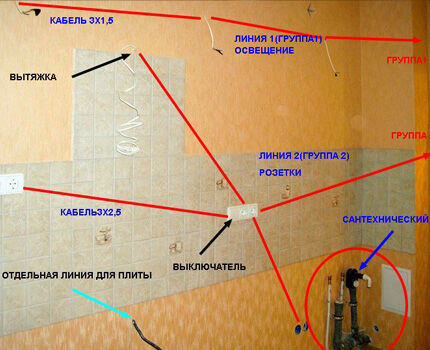
When choosing a wire and laying it, you should be guided by the standards prescribed in the set of rules SP 31-110-2003, clause 9.2. According to them, additional sockets, switches or lamps cannot be connected to the supply line for an electric stove.
For a single-phase network, a three-core wire with a cross-section of 6 mm is used2, and for three-phase - five-core, but with a smaller cross-section.
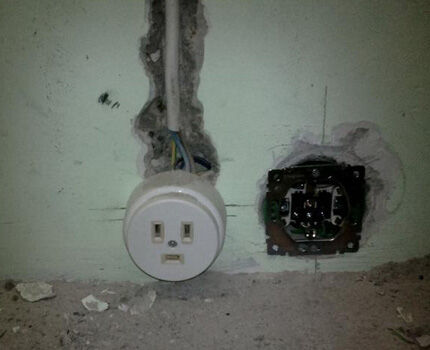
Once you select the right wire, you need to protect it. To do this, a 32 A circuit breaker is installed in the panel for it.Also, for additional electrical safety, it is necessary to install immediately after the circuit breaker residual current device at 40 A.
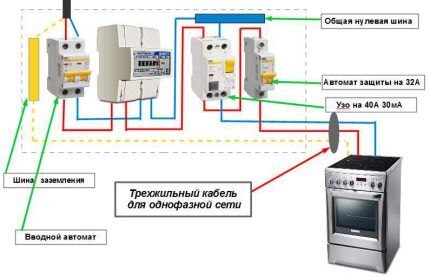
The next step is to purchase a power outlet of the correct power. Its rated current must certainly correspond to the technical characteristics of the machine. If the house has a three-phase network, then it is more advisable to buy a three-phase socket for the installed electric stove.
At choosing a power outlet you should consider what type of installation is to be done - open or hidden. Also, be sure to buy a plug that fits the specific outlet you choose. After all, many foreign-made sockets do not fit domestic plugs. And vice versa.

#2: Choosing a location for the power point
When choosing location points for connecting powerful kitchen appliances, do not forget about safety rules. This outlet should not be located above a work surface or in a location that is difficult to access.
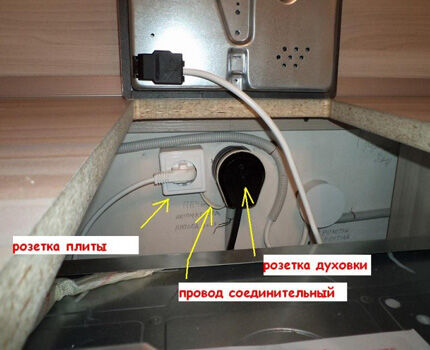
It is strictly contraindicated to install a power outlet for your electric stove in the following places:
- under the sink;
- behind the washing machine;
- dishwasher.
If the stove is installed on legs, then the optimal location for its socket is 15 cm from the floor.It is also important to ensure that the electrical point is kept away from sources of water and fire. According to technical standards, the stove must be immediately plugged into an outlet. For electrical safety reasons, it is prohibited to turn it on via extension cords.

One of the convenient options for its location is behind the stove itself, if the stove can be freely pulled out of the niche and the space allows. Another option is in the cabinet next to the stove. This arrangement will allow you not to worry that the plastic will overheat, and access to it is not difficult.
You can find out more about the layout of kitchen sockets here.
#3: Specifics and sequence of connection
Having decided on the place where you will mount the socket for your new stove, and having laid the power cable there, you can begin installing it. You can do this work yourself or invite an electrician.

If you are going to install a power outlet yourself, you need to take the appropriate tools and the outlet itself. Then turn off the power to the wire you are going to work with. Be sure to check that there is really no current on this line.
In the chosen place for installing the socket, you need to make a mark and, taking a hammer drill, make a hole for the socket cup. This is relevant when installing a hidden power outlet.
Then the power wire laid for these purposes is threaded into the socket box.The protective braiding is removed from it, and the freed multi-colored wires are carefully stripped to 0.8-1 cm. Now they need to be connected to the socket mechanism.
Here it is important to correctly connect the yellow-green wire, which is responsible for the ground, to the grounding contact of the socket - the central one. All that remains is to carefully connect the phase and neutral to the extreme contacts and check that all connections do not fall off. There is no need to tighten too much - the wires may be damaged.

When the quality of the wire connection has been checked, you need to firmly fix the socket box in the wall using alabaster or gypsum mortar. After drying, all that remains is to secure the mechanism itself with screws and screw on the upper insulating housing of the power outlet.
After installation, you need to check whether the outlet works. If everything works, then you can start connecting the stove itself.
If you need to move the socket, we recommend that you familiarize yourself with article.
Power plug connection options
When purchasing an electric stove, buyers receive a bonus from most manufacturers - a plug with a suitable socket. These elements just need to be connected to the stove and the power cable, respectively.
There are various connection schemes. They depend on the supply network entering a private or apartment building. There are such connections:
- single-phase;
- two-phase;
- three-phase.
Manufacturers often put all three connection diagrams on the back of the slab. The home craftsman will only have to remove the protective cover and, guided by the attached diagram, connect all the wires of the stove to the plug.
Sometimes such a diagram is included in the instructions that come with the electric stove. You need to study it carefully and act in accordance with the desired scheme.
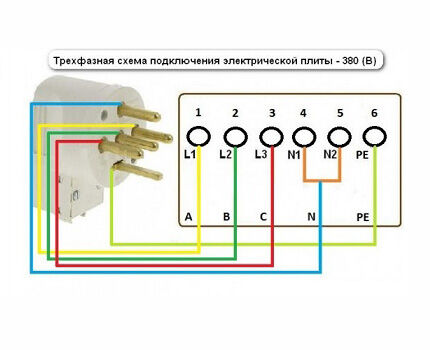
Before we started laying the supply line separately for the stove, we already had to find out which network powers the house. Based on this, a 5- or 3-core wire of optimal diameter was selected. Knowing this nuance, you will have to choose your own from the proposed connection schemes and act.
New buildings often have a three-phase network. When connecting a stove in the kitchen of such an apartment, you should be guided by a three-phase connection diagram.
Its essence lies in connecting the contacts of the plate to the five-core wire of the plug:
- phases A, B, C are connected to terminals L1, L2, L3. In this case, phase jumpers made of copper wire are not used;
- A copper jumper is placed between the zero terminals N1, N2 and the zero wire is connected to it;
- The grounding yellow-green wire is connected to the PE terminal.
Sometimes there is a variant of a two-phase network in a house/dacha, built somewhere at the very beginning of the last century. In order to correctly connect powerful kitchen appliances/stoves in such a situation, you need, depending on the available phases, to place a good copper jumper between the two terminals of the household appliance.
For example, between L1 and L2. Then connect phase A to this terminal, and attach the remaining phase C to terminal L3.
The same high-quality jumper is placed between the zero terminals N1, N2 and the neutral wire is connected. And the earth lead is attached to the PE terminal.

Older houses most often have a single-phase electrical network. In this case, a single-phase connection scheme is used. Here, zero and ground are connected similarly to the two previous circuits, and copper jumpers are placed between the three terminals of the plate. And then the phase wire is connected.
Copper jumpers are often included with the stove. But, if they are suddenly not found, you can use 6 mm copper wire2, disconnecting pieces of the desired size from it. The connection points to the terminals must be carefully crimped to ensure reliable contact with the terminals.
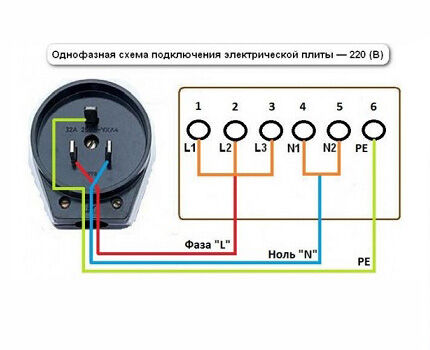
Detailed photo instructions for connecting using a single-phase circuit
You should start by preparing the tools and material.
The next step is connecting the three-wire wire to the electric stove.It is important to choose the right circuit, identify the terminals and not mix up the wires.
After connecting the cable to the stove, you should check the wires in the junction box and install a new outlet.
The final and mandatory stage is testing. It is necessary to check the operation of the outlet, and at the same time the stove.
At this point, the installation of the power outlet and the connection of the electric stove are considered complete. If during operation the socket fails, you can try fix, the main thing is to observe safety precautions during work.
Connecting a stove without an outlet
Sometimes it is not possible to install a power outlet for the stove. But this fact is not an obstacle to its connection. After all, it’s hard to imagine a full-fledged kitchen without an electric stove.
In this case, you can connect the stove directly to the power cable. Sometimes it is placed in a junction box, and all the wires are connected to the corresponding terminal block clamps.
It is also possible that such a box is not standing, and the power cable simply comes out of the wall. The meaning of the connection will not change from this - it will be the same.

First, you need to unscrew the plug of the electric stove and release the wires located in it. These are, as a rule, 3 wires - ground, phase and neutral.
Secondly, you need to disconnect the power line you are going to work with from the network. Be sure to make sure that no power is being supplied to prevent electric shock.
Third, unscrew the screw from the protective cover of the junction box. Here you can see the terminal block to which the cores of the power cable are connected. If the distribution block is not installed, it will be more convenient to install it. This will make the connection more accurate.
Fourthly, the wires of the power plug of the plate must be connected to the corresponding terminals with wires from the distribution box. It is important here not to confuse the colors - connect the yellow-green grounding conductor of the plug with a similar power wire in the box. Connect the phase and neutral wires in the same way.
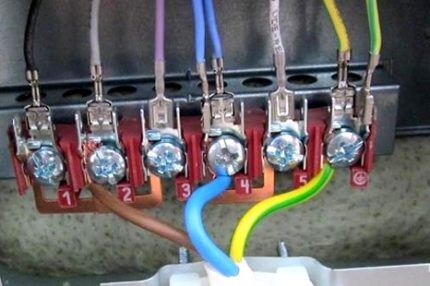
When the connection is completed, you need to put back the protective cover of the junction box and tighten the screw. That's it - you can check the functionality of the electric stove.
It is important not to forget that using this type of connection, the consumer loses the warranty. If a breakdown occurs before the warranty period expires, you will have to repair the equipment at your own expense. This is one of the unpleasant aspects of such a connection.
But there are also positive aspects. So, if in the near future you plan to replace the old stove, then, working with the junction box, it will not be difficult to connect everything new.

Conclusions and useful video on the topic
Detailed video about installing a power outlet in an overhead way and connecting the power plug to an electric stove:
A visual video of connecting the cable to an electric stove according to the diagram provided by the manufacturer:
Video about connecting an electric stove to a power outlet with a plug left over from an old stove:
You can connect a power outlet without involving electricians. To do this, you need to choose the right device, taking into account the power of the equipment that will be turned on. The main thing is to lay a separate cable specifically for the stove and secure it by installing a circuit breaker and an RCD. The installation process itself is no different from installing a regular outlet.
Do you have experience in installing a socket for an electric stove yourself? Or maybe you don’t agree with the material presented? We look forward to your comments and questions.
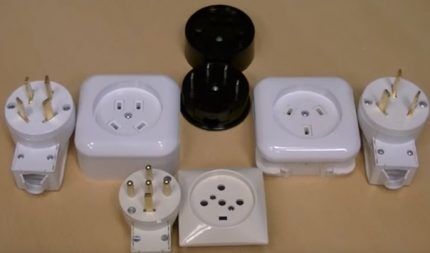




When we moved into the new apartment, it turned out that the builders had not installed an outlet for the electric stove in the kitchen. There was only one conclusion - wires sticking out of the wall. I connected the stove myself, and on the advice of the salesman in the store, I bought not a socket, but some kind of closed-type device.It was necessary to connect the wires sticking out of the wall into it, and from it - lead the cable to the stove. Out of ignorance, I did not take care of the sufficient length of the cable, and now it is problematic to move the slab away from the wall, much less move it to another place, without destroying the closed structure. Don’t repeat my mistake - if you connect without a normal socket, the cable to the stove must be of extra length!
In general, during installation, you need to make sure that the socket meets the safety standard so that a short circuit or even a fire does not occur in the future. The power outlet must be grounded. To connect, you must use a separate circuit breaker; the wire cross-section is allowed to be at least 8 mm; wiring is only suitable for copper. When selecting an outlet, look at both the characteristics of the network and the characteristics of the stove.
Well, you are a sheep, Bogdan -8mm???
Aren't you a sheep? It’s clear what was meant - 0.8.
Alex, 0.8 mm for O_o tiles
Even for 1.5mm light. For an electric stove it’s 4-6mm, but not 8. This is not an industrial installation. Usually the plates are 7-9 kW, and 4 mm is enough. Just look at the input circuit breaker, if, for example, 40A, then you still won’t connect more than 7 kW. A 10mm cable is 70A, it definitely doesn’t happen in apartments, in houses only if there is a 3-phase input.
I'm planning to buy an electric I don’t know whether to make the stove myself or invite a specialist. In this article, everything seems to be written clearly and understandably. Please tell me, has anyone tried to install it on their own and what difficulties did they encounter in the process? I would be grateful for your answer)
In fact, the first difficulty you may encounter when connecting an electric stove if you live in a multi-story building is grounding. This is especially true for apartments above the fifth floor; I think many people know how difficult it is to install grounding in old panel houses so that everything is in accordance with standards and safety regulations.
Installing the wiring itself is a rather troublesome process, especially if repairs have already been made and there is no possibility of hidden installation of sockets and wires. In such cases, the overhead sockets of the wire box will come to the rescue. I installed an electric stove at my home; during the renovation, I pre-installed the wiring; my brother had to use a box and overhead socket.
Maybe someone can tell me what to do in my situation. How to connect a stove that is designed for 2 phases, but I have a cable sticking out from the wall for 3 phases? Just don’t use one phase and connect through terminal blocks or what?
Hello, please tell me. We were connected to a new stove, without an outlet, the power wire went straight into the stove, I decided to cook in the oven, turned on the oven, it started to heat up, smoke came from the oven itself, and from the back where the wire was connected. Before this, there was no such outlet at all, that is, an electrician brought a new cable, installed it and connected it.
Hansa tiles, maybe there was smoke in the back, it became scary. Turned off the oven. Maybe it's because the wire is new?
Good afternoon, Julia. All home appliances are connected to the network via sockets. Call an electrician again to redo the connection. You will find the rationale in “SP 256.1325800” - I have attached a screenshot.
Regarding the smoke from the oven, if the cable began to short-circuit, the circuit breaker in the floor panel would trip. I think you didn’t wash the oven before turning it on or there were flammable objects behind the casing.
I read that there could be smoke coming from the oven, but it was very scary from behind...
The current of the socket must correspond to the current of the consumer, as well as the permissible current for the cable. The machine limits this current.
Good afternoon. You will need to connect the electric stove yourself. Tell me, please, in a single-phase socket, it doesn’t matter where to connect the zero and phase? As I understand it, the main thing is that the grounding is on the correct contact?
Tell me, how to properly connect the hob and oven if one end of the 6mm2 wire is sticking out of the wall?